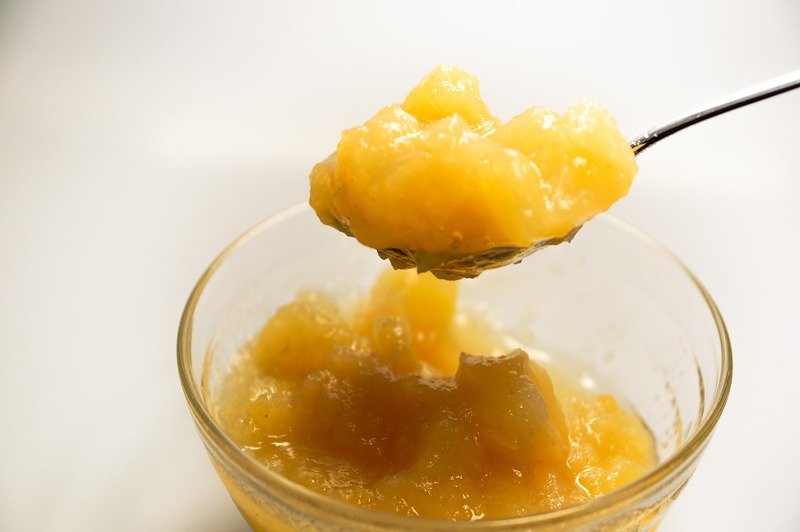Sure, easy ways are present when removing molds after recognizing and locating them. Still, have you ever guessed what does mold on applesauce look like?
Got an idea on how to prevent such molds from turning your applesauce into a waste? Find your answers right here!

Besides the mold-prone parts of your home, your homemade and store-bought fruit pulps may also be victims of mold growth. Many foods are a “willing prey” to mold infestation—including your pouched or even in-jar applesauce.
Here, we’ll scout you on how to spot molds in your applesauce, plus we’ll give tips on preventing mold contamination and protecting your family from possible illnesses.
Identifying Mold In Applesauce
Fruit purees such as applesauce indeed taste delicious and satisfying. It is also a healthy alternative to artificial and unhealthy sweets to feed your kids.
However, if molds begin to infest it, its consumption may cause health problems or merely an upset stomach.
Mold-contaminated applesauce would appear to have white, greenish, or grayish to black chunks of furry and unpleasantly-looking dust. Some applesauce can also develop orange molds.
If you have been buying applesauce in pouches that unfortunately do not have transparent packaging, mold may grow unnoticed. In this case, you may unknowingly discover mold growth in your puree after tasting it.
Molded applesauce or any other food tastes and smells earthy and unpleasant, so you can quickly identify if it has mold in it. Yet, unlike in packets, you can quickly visibly spot molds in applesauce contained in a clear jar.
Aside from purees, dairy products such as cheese can also develop molds externally, which is not safe. If you happen to have molded cheese at home, you may check on this informative article about molds on cheese that tackle the safe and unsafe types of cheese molds.
Reasons Why Applesauce Develops Mold
Suppose you wonder what causes mold growth in your applesauce. In that case, you can always blame the air and moisture as the primary ingredients for mold production and reproduction.
Listed below are some specific culprits behind disgusting applesauce mold growth.
- Non-airtight container – As molds begin to grow and float in the air, they may start to dwell in the jar-packed applesauce even before the lid is put on and sealed.
- Over blending of puree – An apple’s volume is composed of a quarter of air, which makes it prone to enzymatic reaction. Observe that freshly cut apples immediately turn brown even after only a couple of minutes of air exposure.
- Unthorough preparation of ingredients – Fresh apples naturally have organisms in their skin that may trigger molds to grow.
How To Prevent Mold In Applesauce
Now it’s time to find out ways to prevent molds from ruining your applesauce.
1. Sealing the lid
You may have difficulty preventing the air from sitting on and in between your puree — air bubbles are the most difficult ones to deal with. A recommended way to prevent it is to boil down the puree and ensure a slight boil while pouring the processed puree into the jar.
Siphoning in processed apples can also cause the product to overflow, making it difficult to seal the container completely. In this case, you can use an elastic knife and a bubble freer to pop out and remove air bubbles.
Allow also a half-inch top-space in the jar to put up with product expansion during the process. Processing the puree in an atmospheric steam canner can give a more robust lid seal.
2. Adding acids
Acid is a common enemy of molds. You can add to your applesauce recipe ascorbic acid, such as one-part lemon juice, to every quarter of the puree.
It increases the acidity and conserves the color of the mixture.
Some cases of mold growth also point out the inadequate heating of applesauce. It is essential to boil it at the right temperature to prevent enzymatic reactions and air in the headspace.
You can also try equalizing the temperature of the container and the applesauce. To do this, put the jar on heat and wait for a few minutes before removing it.
3. Washing ingredients and boiling equipment
Thorough washing and peeling of the fruit before cooking can reduce the possibility of molds. Maintaining a clean kitchen can also help prevent the existence of mold-causing bacteria.
Always ensure sanitation of your hands, utensils and equipment, and kitchen counter. If you’re storing your applesauce in a freezer, ensure that the freezer is free from mold growth.
Contamination can happen if you handle and store foods carefully. If you encounter mold infestation in your freezer, worry less as we have you covered with this freezer mold removal and sanitation guide.
Conclusion
Now that you know what does mold on applesauce look like, you can effortlessly apply the ways to prevent it from ruining your puree. Although accidental consumption of molded applesauce is relatively safe, ensuring the cleanliness and freshness of the foods you feed to your family should be your priority.

If you encounter mold in jarred applesauce that’s open and refrigerated a few weeks, can u remove it and safely eat it?